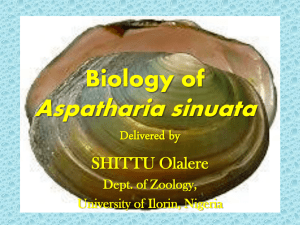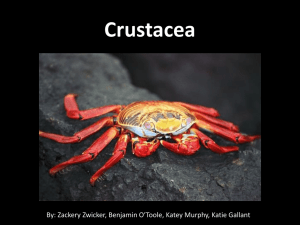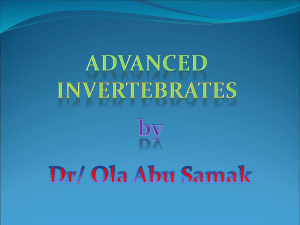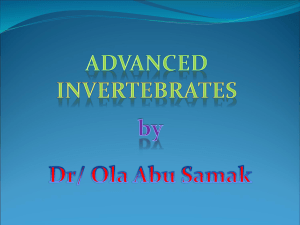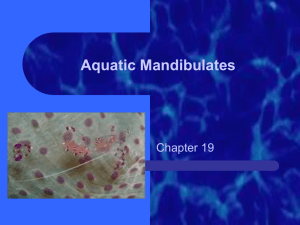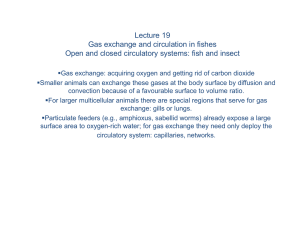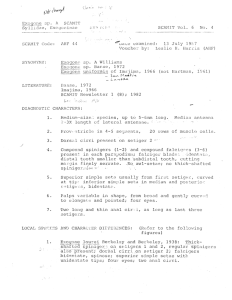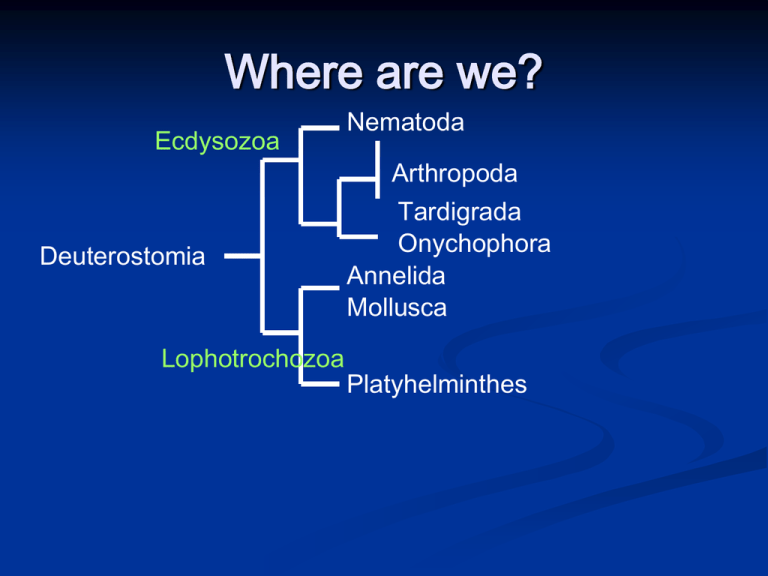
Where are we?
Ecdysozoa
Deuterostomia
Lophotrochozoa
Nematoda
Arthropoda
Tardigrada
Onychophora
Annelida
Mollusca
Platyhelminthes
Phylum Arthropoda
Subphylum Crustacea
Crustacea
Terrestrial and aquatic
All depths in marine, brackish, and
freshwater
> 67,000 described species, likely 5-10x
that number no yet described
Diverse form, size, and habitat
5 classes, 34 orders
Characteristics
Head = 5 segments, trunk divided into
thorax and abdomen
Carapace or cephalic shield
Appendages multi-articulate; either
uniramous or biramous
Mandibles are modified limbs that function
as jaws
Gas exchange by diffusion across
specialized surfaces
Characteristics
Excretion by nephridia
Simple and compound eyes in at least one
life cycle stage
Compound eyes on stalk
Gut with digestive cecae
Nauplius larvae, either mixed or direct
development
2 pairs of antennae
Crustacean Bauplan
Thorax
anterior
segments fused = cephalon
Maxillipeds:
additional mouthparts
Number of segments in thorax varies
Thorax appendages = pereopods
swimming, walking, gas exchange, feeding,
defense
ultiarticulate and biramous
Basic Crustacean Bauplan
Abdomen
Segments
Number of segments used in ID
Appendages = pleopods
Biramous, flap-like
swimming
Culminate in telson
Anus
caudal rami
w/uropods (last pair of abdominal appendages) forms
tail fan
Adult Crustacean
Crustacean Bauplan
Nauplius Larvae
Single, median, simple eye
3 pairs of sectioned, functional limbs
Become antennules, antennae, and mandibles
Diagrams
adult Crustacean diagram:
http://www.enchantedlearning.com/subject
s/invertebrates/crustacean/index.shtml
Circulation
Open circulatory system
Dorsal ostiate heart
Internal organs bathed in fluid
Simple heart and vessels in most
Sessile species no heart; pumping vessels
Blood
Variety of cell types
Dissolved hemoglobin or hemocyanin
Explosive cells release a clotting agent at injury sites
Heart Shape
Heart long and tubular; to
postcephalic region
Or, globular, box shape, in thorax;
association with thoracic gills
Gas Exchange
Aquatic
Small organisms = diffusion
Concealed gills for protection, prevent
dessication
External gills
Modified thoracic limbs
Gills are thin; maximize gas exchange
Most species beat gills to maintain flow
Gas Exchange
Terrestrial
Cutaneous Respiration
Membranes on legs of some species
Gills
Concealed
Pseudotrachea
Internal blind sacs to outside through small pores
Air in sacs, gas exchange with blood
Internal gills moist
Water currents
Hydraulic vacuum
Filter feeding
Feeding basket
Passive
Twirling antennae
Direct manipulation
Sand grazers or Sand lickers
Predators
Parasitism
Water Currents
Thoracic limbs for swimming and creating
suspension feeding currents
Water drawn into space
Particles trapped by setae
moved to food groove and toward head
Hydraulic vacuum
Mouth appendages = paddles
Water containing food drawn into interlimb
space
Food particles are not filtered, but captured in
small parcels of water
Individual algal cells are captured this way
Filter feeding
Sessile crustaceans have feathery cirri to filter
feed
food up to one mm
= detritus, bacteria, algae and various
zooplankton
Some can coil cirrus around large prey in a
tentacle fashion
Filter feeding in slow water
Extend pairs of cirri like a fan
Sweep rhythmically through water
Filter feeding in fast water
Allow water to run through filter
video
Passive feeding
Use cirri to passively strain
Burrow into sand with anterior facing
upward
Extend cirri to capture bacteria, protists
and phytoplankton
Antennae brush food towards mouth
Twirl antennae
Create spiraling currents that bring food
toward mouth
Food entangled in setae near base of
mouth, brushed in
Direct manipulation
Manipulation by mouthparts, pereopods
and subchelate anterior legs
Sand grazers or Sand lickers
Brush sand grains with setose mouthparts
Select individual sand grain, rotate and
tumble against mouthparts to remove
organic material
Predator
Grab prey with chelae pereopods
Tear, grind and shear with mouthparts
Hunters or ambushers use raptorial
subchelae to stab, club or smash prey
Some hold prey in cage using endopods;
others inject and suck out tissues
Snapping Shrimp
Use large cheliped to snap close:
produces loud popping sound and “shock”
wave
Pressure wave stuns prey, pull into burrow
Snapping Shrimp Video
http://www.sciencemag.org/feature/data/1052273files/video.shl
Digestive system
Foregut
Lined with cuticle that is continuous with
exoskeleton, molted
Short pharynx-esophagus, stomach
Stomach = chambers for storage,
grinding and sorting
Midgut
intestine
Length varies with body shape and
size, diet
digestive ceca
Hindgut
Short,
to anus
Foregut functions
transport food to midgut and/or processing by
chemical digestion
cardiac stomach = storage, bits are moved
past gastric mill (sclerotized teeth for grinding)
pyloric stomach = filter large particles
midgut, hindgut and anus
Excretion and Osmoregulation
Ammonia by nephridia and gills
nephridial excretory organs as antennal
glands (green glands) or maxillary glands
Inner blind end is coelomic remnant of
nephridium = sacculus
Sacculus
Actively remove and secrete material from
blood into excretory lumen
metabolic waste removal and water and
ion balance
Other osmoregulation
Thin areas of cuticle
Gill surfaces
terrestrial isopods: ammonia diffuses from
the body as gas
Nervous System and Sense Organs
CNS
Brain: three fused ganglia
Protocerebrum
Deutocerebrum
Tritocerebrum
Primitive nervous system = ladderlike
Nervous System and Sense Organs
variety of sensory receptors
innervated setae or sensilla: contain
mechanoreceptors and chemoreceptors
Propioceptors
Animals in Class Malacostraca: statocysts
Nervous System and Sense Organs
Two rhabdomeric photoreceptors:
Median simple eyes
Lateral compound eyes
Most possess both, either simultaneously
or during development
Naupliar eye = primitive, secondarily lost
Nervous System and Sense Organs
Lateral compound eyes
Lack visual acuity
Discern shapes, patterns and movement
Color vision in some
Lacking in many taxa
Nervous System and Sense Organs
Underwater vision
Problems with angular distribution of light, lower
intensity, and narrow range of wavelengths than
in air
Solution: Mount eyes on stalks, increase
information available to eyes. Increases field of
view, and binocular range
Nervous System and Sense Organs
Complex Endocrine and Neurosecretory
Systems
Not well known
Molting, chromatophore activity, and
reproduction under hormonal and
neurosecretory control
Bioluminescence in several groups
Reproduction And Development
Reproduction
Exploit virtually every life history scheme
imaginable
Usually dioecious
Hermaphroditism in remipedes,
cephalocarids, cirripedes, few decapods
Parthenogenesis common among
branchiopods and certain ostracods
Reproduction And Development
Reproduction Systems
Gonads paired structures in trunk
Pair of gonoducts from gonads to genital
pores on trunk segment
Male pair of penes, or single fused median
penis
Female include seminal receptacles
Reproduction And Development
Most crustacea copulate
courtship behavior
Pairing more or less permanent, or seasonal
Reproduction And Development
Fiddler crab example
Males use cheliped waving to attract females, repel
competing males
Males produce sounds by stridulation, substratum
thumping to attract mates
Mating when male entices female into burrow
Reproduction And Development
Reproductive systems continued
Sperm transferred either loose in seminal
fluid or packaged in spermatophores
Sperm deposited directly into oviduct or
into seminal receptacle
Sperm can be stored for long periods

